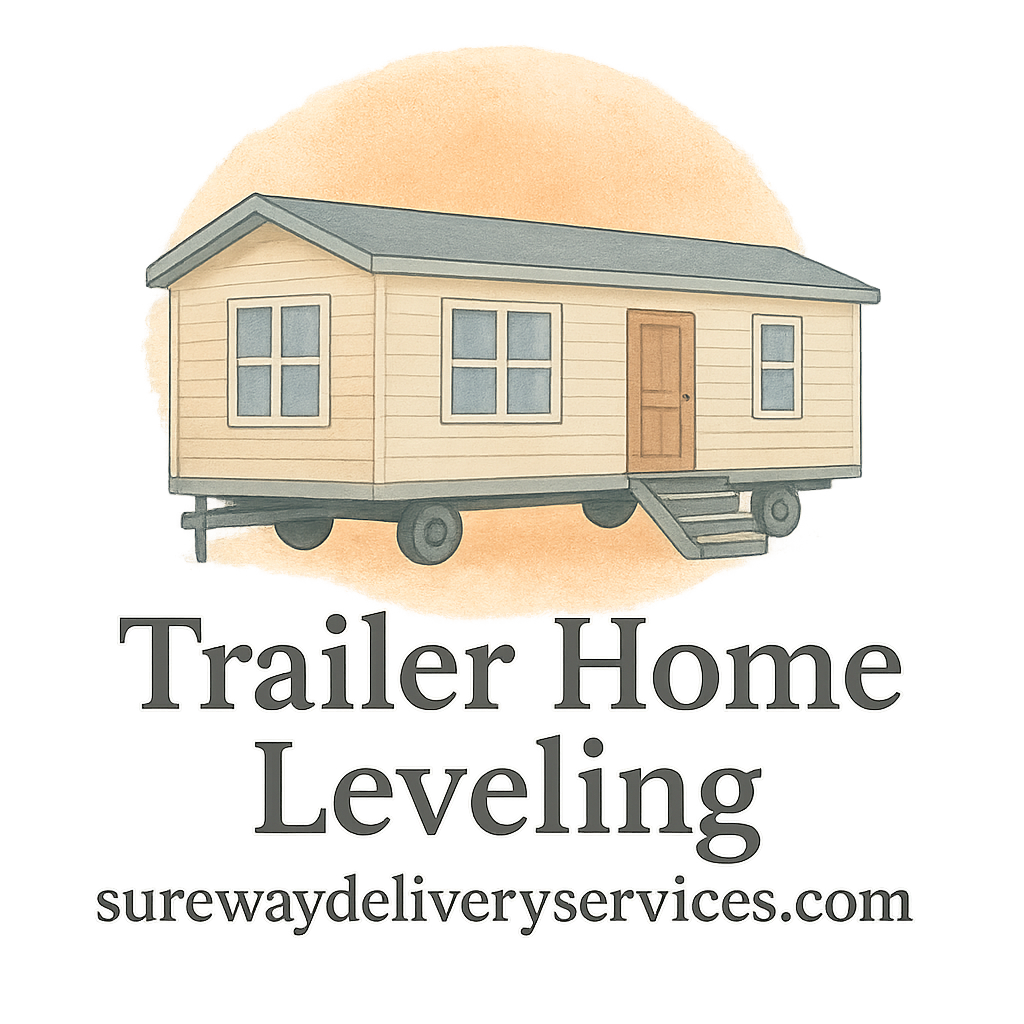Introduction
Let’s face it — not all trailer homes are created equal. And if you’ve ever noticed your doors sticking or your floors sloping, you know that trailer home leveling is a real concern. But did you know that the materials used in your trailer home can significantly affect how often you’ll need leveling?
In this guide, we’ll break down six common trailer home materials and how they directly impact your home leveling needs. Whether you’re a seasoned trailer owner or just getting started, understanding your materials means fewer headaches and smarter maintenance.
Ready to make leveling stress-free? Let’s dive in.
Why Trailer Home Materials Matter for Leveling
Your trailer home sits on a foundation — and that foundation responds to environmental stress, weight, and material flexibility. The type of material used for frames, exteriors, and support systems affects how your trailer settles, shifts, and stays level over time.
Material properties like expansion, contraction, and moisture absorption play a huge role in how your home behaves. And that’s where leveling needs differ from one trailer to another.
For a primer on the basics, check out this introduction to trailer leveling.
Material #1: Wooden Frames
How Wood Affects Leveling
Wood is a classic material used in many trailer homes, especially older models. But here’s the deal — wood expands when it gets wet and contracts when it dries. That means constant movement, which spells trouble for staying level.
Wood can warp, rot, or get termite damage. And when your base structure shifts, it throws off your entire home’s balance.
Signs of Wood Frame Shifting
- Warped floorboards
- Stuck doors and windows
- Uneven cabinets
- Visible gaps in siding
Maintenance Tips for Wood Frames
- Use moisture-resistant sealants
- Inspect yearly (especially after heavy rain)
- Monitor leveling annually with inspection checklists
Learn more about trailer maintenance and inspections here.
Material #2: Steel Beams
Strength vs. Flexibility
Steel sounds like a superhero material — and in many ways, it is. It provides rigid support and doesn’t degrade like wood. But steel isn’t perfect. Over time, especially with poor drainage underneath, steel beams can corrode or warp under constant pressure.
When Steel Starts to Sag
- Dips in the center of the trailer
- Uneven pressure on the piers
- Twisting along the main support beams
Inspection Tips for Steel Beam Homes
- Check for rust and oxidation yearly
- Repaint exposed areas to prevent corrosion
- Hire pros with experience in steel trailer leveling from the service hiring section
Also, check out our tools and jacks tag for equipment that helps with steel support correction.
Material #3: Concrete Foundations
Benefits for Long-Term Leveling
Concrete is the rockstar of permanent support. Homes placed on poured concrete slabs or piers enjoy long-term stability. That means less frequent leveling — if the concrete is done right.
Risks with Concrete Cracks
But nothing is bulletproof. Soil shifting can still crack concrete. And once cracks begin, moisture invades and causes movement.
Key tip: Look for spider-web cracks and rising edges around the perimeter.
To understand more about budgeting for repairs like this, check the cost and budgeting guide.

Material #4: Vinyl Siding and Skirting
Appearance vs. Structural Impact
Vinyl siding isn’t structural, but the skirting plays a hidden role in temperature and moisture control. Poor skirting can trap moisture under your trailer — and that affects the core materials.
When Skirting Hides Bigger Issues
Ever seen a perfectly clean trailer that still has soft spots in the floor? That’s probably because the skirting masked an underlying leveling issue.
Bonus: Use skirting ventilation to avoid condensation damage.
For smarter upkeep, follow this trailer maintenance checklist.
Material #5: Aluminum Exteriors
Lightweight and Level-Sensitive
Aluminum is popular for its sleek, lightweight look. But the flip side? It’s very sensitive to leveling changes. A tiny shift in support and you might notice warping or panel separation.
Expansion and Contraction Problems
Aluminum reacts to temperature. Hot days expand it, cold nights shrink it. If your trailer isn’t properly leveled, these small movements can add up.
Find real user stories about these issues on our success stories tag.
Material #6: Composite Materials
Durability Over Time
Modern trailer homes often use composite panels or reinforced synthetics. These offer superior moisture resistance and structural integrity — but they’re not indestructible.
Cost vs. Performance Trade-Offs
Composites reduce your long-term maintenance needs but can be expensive to repair. Knowing when to relevel based on subtle shifts is essential.
Explore cost tips for leveling services before investing in composite repairs.
How to Tell When You Need Leveling
Common Trailer Leveling Issues
- Cracks in the walls
- Sloped floors
- Loose or squeaky fittings
- Trouble closing doors and windows
Explore the most reported trailer issues on our site.
Regular Trailer Maintenance Matters
Staying level starts with regular checkups. Don’t skip seasonal inspections or you’ll be facing pricey realignment work.
Review annual trailer inspections to stay ahead.
Leveling Techniques Based on Material Type
Jacking, Shimming, and Resurfacing
Not every material can be treated the same. Wood-framed trailers might need full jacking. Steel homes may require welding or extra bracing. Concrete-based homes often involve resurfacing.
How Material Determines Technique
- Wood → shim and reset
- Steel → hydraulic leveling
- Concrete → pier resetting or slab adjustments
For more on techniques and methods, read this full breakdown.
Hiring the Right Service Team
Why Experience with Specific Materials Counts
A contractor who’s great with concrete might not be ideal for a wood frame home. Make sure they know your material inside and out.
Avoiding Overcharges and Getting Value
Use reviews to your advantage. Filter by material type under our customer reviews tag to find experts.
Avoid scams and markups with help from our overcharge awareness page.
Budgeting for Material-Sensitive Leveling
Budget Planning Tips
Always plan a buffer of 15-20% for surprises. Get quotes for your specific material needs — don’t fall for generic pricing.
Hidden Costs Based on Material Type
- Wood: moisture damage repairs
- Steel: rust treatment
- Concrete: pier or slab lift
Track costs with our price estimation tools.
Conclusion
At the end of the day, the materials used in your trailer home aren’t just cosmetic — they dictate how your home reacts to time, weather, and structural stress. Understanding these six key trailer materials gives you a leg up in preventing costly leveling issues before they spiral out of control.
From wood to composite, steel to vinyl, each material has its own quirks — and now, you’re armed with the knowledge to handle them like a pro.
Need help getting started? Visit our main site at TrailerHomeLeveling.com for step-by-step guides and service resources.
FAQs
1. How often should I level my trailer home if it’s wood-framed?
You should check leveling annually, especially after rainy seasons. Wood is sensitive to moisture.
2. Is steel better than wood for trailer home frames?
Yes, steel is generally more durable, but it still requires inspection for rust and sagging.
3. Can vinyl siding cause leveling issues?
Indirectly, yes. Poor skirting traps moisture, affecting the underlying materials.
4. What is the most stable foundation material for trailer homes?
Concrete offers the best long-term stability, though it’s more expensive upfront.
5. Do composite materials eliminate the need for leveling?
Not entirely, but they do reduce the frequency due to their high durability.
6. What’s the average cost to level a trailer home?
It varies based on material, but you’re looking at $500 to $1,500 for most cases. Learn more here.
7. Where can I find reliable trailer home service providers?
Start with our service hiring recommendations and read verified customer reviews.


